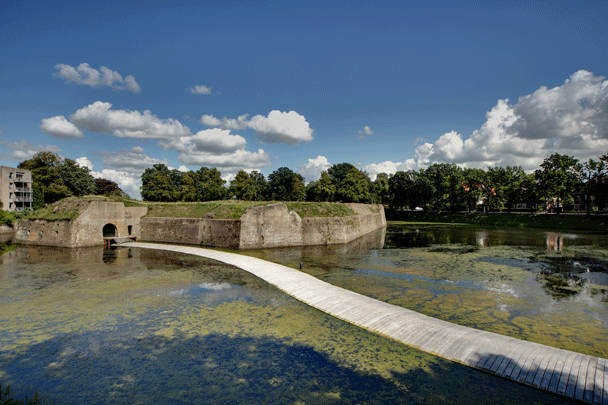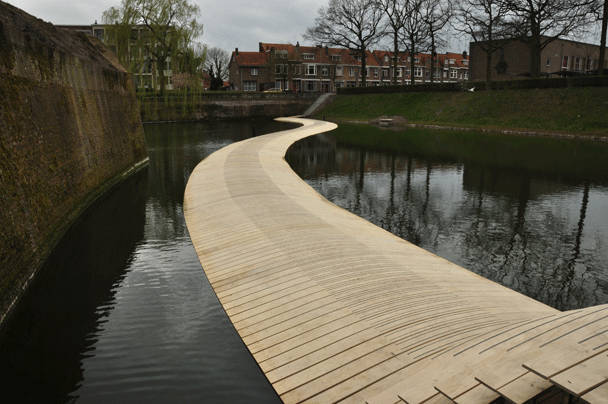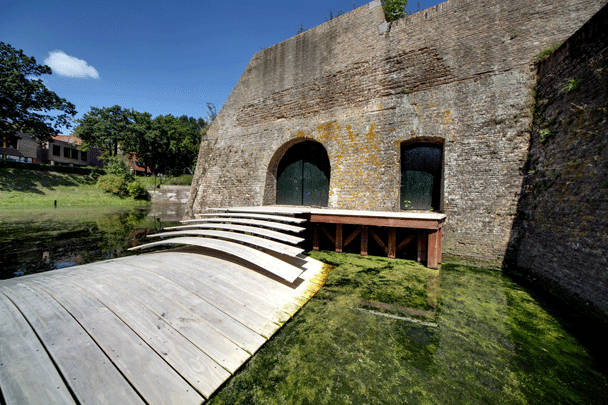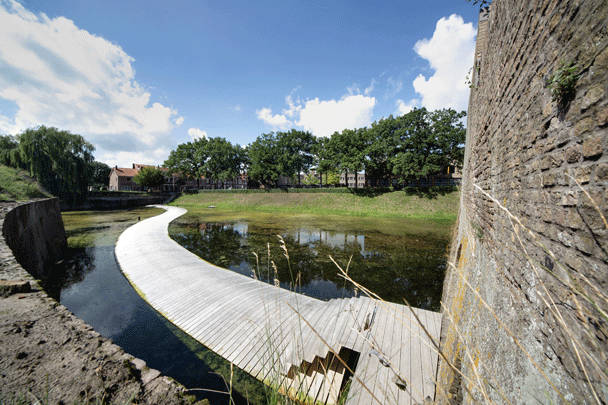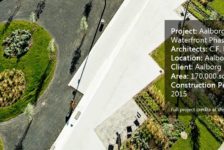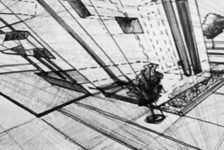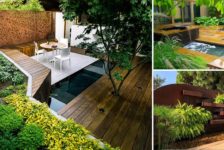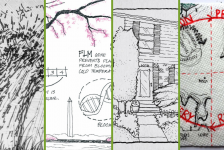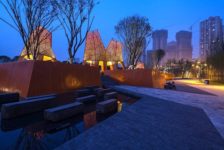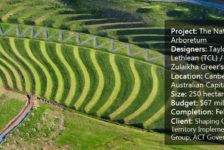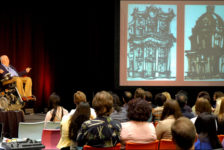The Ravelijn floating pedestrian bridge, by RO&AD. The Ravelijn Bridge, designed by RO&AD, is an 80-meter long pedestrian bridge in Bergen op Zoom, the Netherlands. The primary function of the bridge is to connect the mainland city to a fortress, which is surrounded by a moat. The Ravelijn is currently used for small public and private events and stands as a time capsule to the beginning of the 18th century. The island fortress was once only accessible via boat. All of the materials used to build the fort had to be paddled across the moat by workers. Paddleboats were also used to transport visitors to and from the fortress. When in a paddleboat, visitors traveled a somewhat meandering path through the water. With this historic image in mind, the designers created a pedestrian bridge that mimics the pathway of the boats.
Modern day visitors have a similar experience as the bridge does not take a straight course but rather snakes from mainland to the island. Giving visitors as authentic of an experience as possible creates a lasting impression and gives them a glimpse into the reality of the time period in which the Ravelijn was built. This connection to history creates a more meaningful experience and provides a strong connection to the culture and people of the Netherlands. The Bridge Adapts to Climatic Conditions The Raveljin Bridge displays a superior level of flexibility and adaptability. The bridge is constructed out of wood set on floating tubes. As the season changes, the water level fluctuates. Instead of closing the bridge because it is rendered impassable during rainy seasons, the bridge is designed to float and raise or fall with the water level. Forward thinking designers developed this concept through sketches, drawings, and physical models and came up with a solution that is well adapted to the seasons. Just as many other designers are thinking about holistic design, this bridge was designed with a cradle-to-cradle mindset. This means that materials were responsibly acquired with the end use in mind. This bridge is designed to be dismantled at the end of its life, in at least 20 years, and either reused or recycled. This helps reduce the amount of waste that enters the landfill and sets a precedent and an example to other designers and visitors as they visit and learn about the project. Related Articles: Visually, the bridge also adapts to its environment in color, form, and geometry. The convex design of the bridge allows it to seamlessly fit into its surroundings. The bridge is designed without handrails so as to not obstruct views. Nothing about the bridge is designed to stand out, make a dramatic statement or draw attention.3 Design Lessons Learned from the Floating Bridge
The Ravelijn Bridge offers students and professionals with a few lessons in design: 1. Design with the context in mind. The strength of this design is due to the convex nature allowing for maximum interaction between visitors on the bridge and the context. Getting visitors as close to the water as possible is another strength of this Ravelijn Bridge design. 2. Do your research. Allow the history of the site to inform the design. It’s important to find out what historical structures are nearby or were formerly there and how they were used. In this case, allowing the path of paddleboats from the fortress to the mainland to dictate the course of the bridge pays homage to the history of the site.
3. Design continues into material selection. Make a conscious effort to specify sustainably harvested and locally manufactured materials. It’s always an added bonus to know the materials can be recycled or reused when the site is later adapted to meet different needs. The Ravelijn Bridge breaks away from the form of a traditional bridge and while not supported by cables, columns or piers, it still delivers an important connection and pedestrian passageway between the city and fortress. Providing a precedent for cradle-to-cradle design, it also seamlessly integrates into its surroundings in form and geometry. The Ravelijn Bridge spans the gap between context sensitive design and creative problem solving. Recommended Reading:- The World’s Most Amazing Bridges (Landmark Top Tens) by Michael Hurley
- Bridges: The Science and Art of the World’s Most Inspiring Structures by David Blockley
Article written by Rachel Kruse Return to Homepage
Published in Blog


